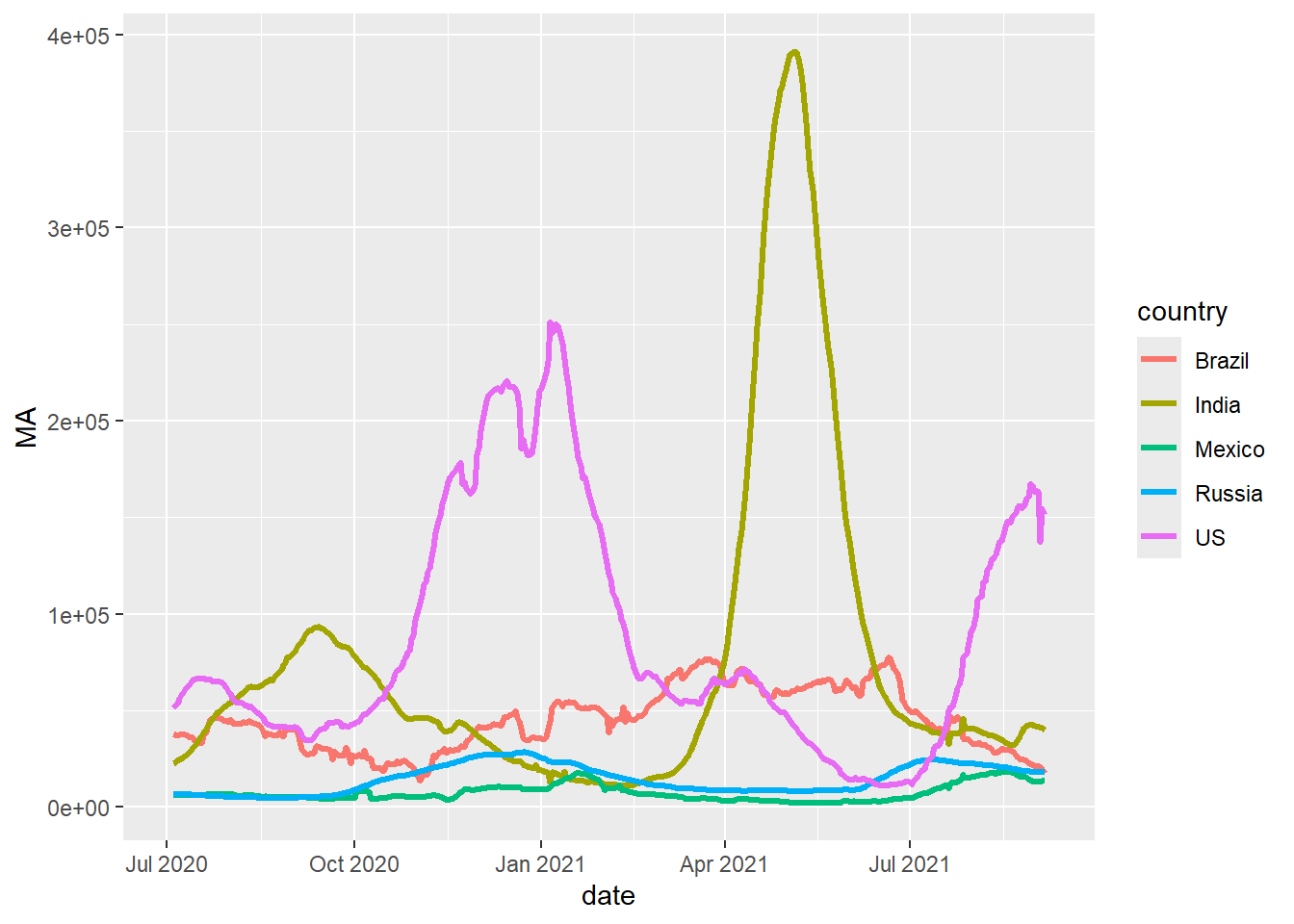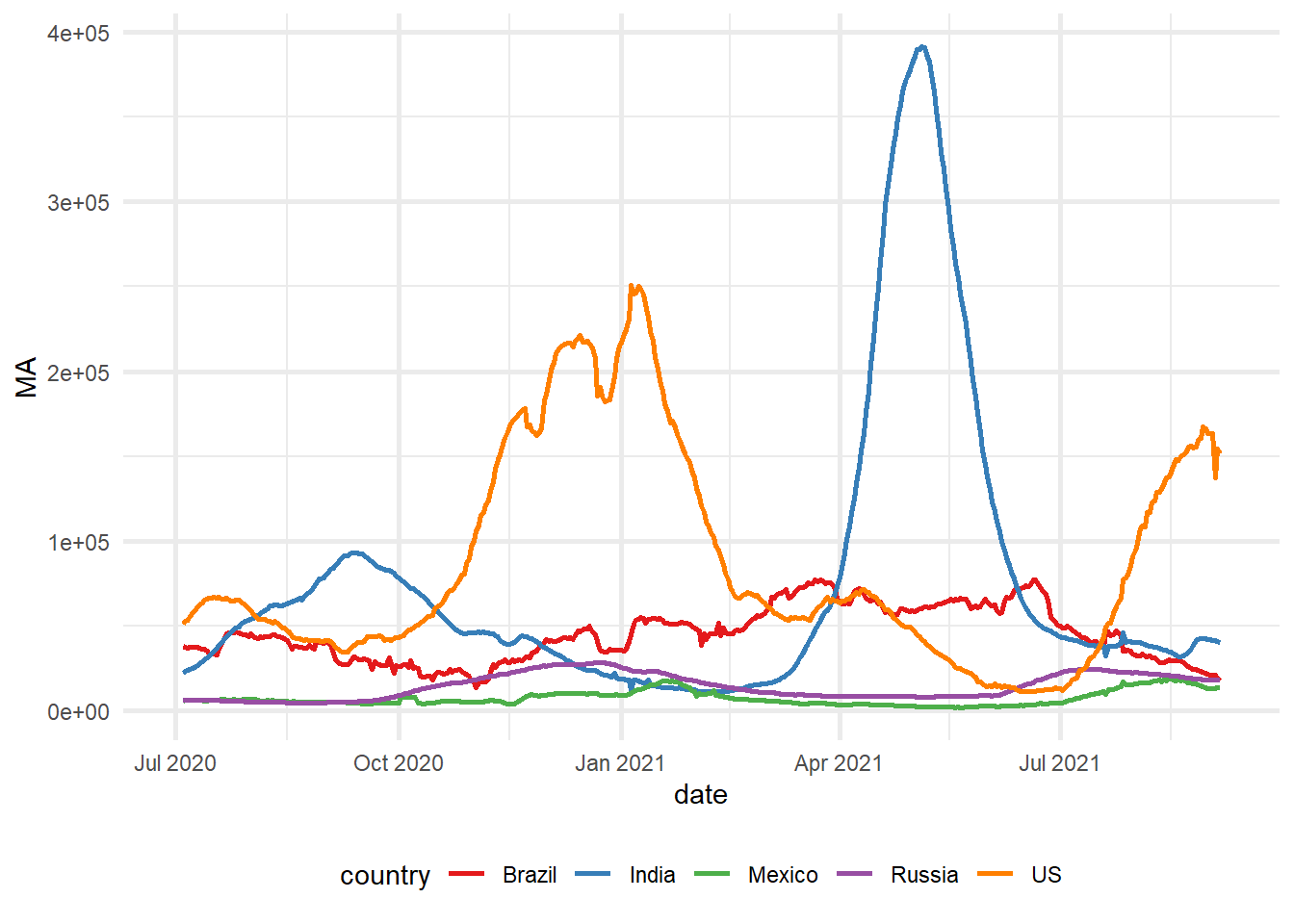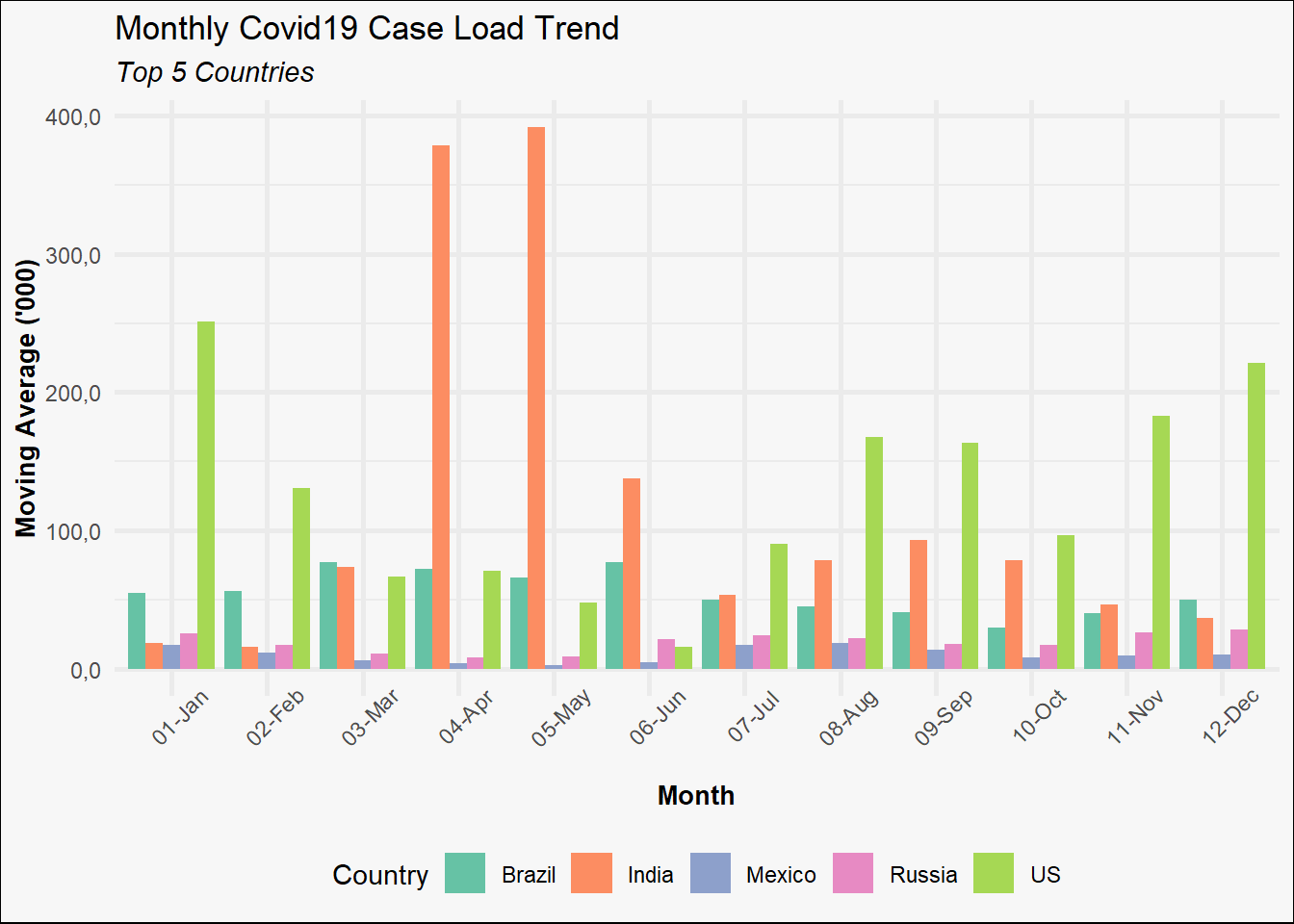# Load required packages
library(dplyr)
library(ggplot2)
library(scales)
library(stringr)Developing Custom Charting Functions with ggplot2
Introduction
While R provides numerous options for two-dimensional graphics and data visualization, ggplot2 offers great functionality, features, and visual quality. This tutorial shows how to develop customized charting functions for specific visualization types, utilizing ggplot2 as the foundational visualization engine. The approach enables the creation of reusable, standardized visualization components suitable for production environments and analytical workflows.
Package Dependencies
Dataset Acquisition and Preparation
This tutorial utilizes a summarized version of the COVID-19 Data Repository maintained by Johns Hopkins University to demonstrate custom charting function development.
# Load COVID-19 data
df <- read.csv("https://bit.ly/3G8G63u")
# Get top 5 countries by death count
top_countries <- df %>%
group_by(country) %>%
summarise(count = sum(deaths_daily)) %>%
top_n(5) %>%
.$country
print(top_countries)[1] "Brazil" "India" "Mexico" "Russia" "US" Subsequently, we prepare the dataset for visualization by calculating a 7-day centered moving average of daily confirmed cases for the identified top five countries:
# Create a data frame with the required information
# Note that a centered 7-day moving average is used
plotdf <- df %>%
mutate(date = as.Date(date, format = "%m/%d/%Y")) %>%
filter(country %in% top_countries) %>%
group_by(country, date) %>%
summarise(count = sum(confirmed_daily)) %>%
arrange(country, date) %>%
group_by(country) %>%
mutate(MA = zoo::rollapply(count, FUN = mean, width = 7, by = 1, fill = NA, align = "center"))Fundamental Line Chart Function Development
The initial implementation demonstrates the creation of a basic line chart function. Note the utilization of aes_string() instead of aes(), which enables the provision of arguments to ggplot2 as string parameters, thereby enhancing function flexibility and programmability.
# Function definition
line_chart <- function(df,
x,
y,
group_color = NULL,
line_width = 1,
line_type = 1){
ggplot(df, aes(x = !! sym(x),
y = !! sym(y),
color = !! sym(group_color))) +
geom_line(linewidth = line_width,
linetype = line_type)
}
# Test run
line_chart(plotdf,
x = "date",
y = "MA",
group_color = "country",
line_type = 1,
line_width = 1.2)
Custom Theme Development
Having established the methodology for encapsulating ggplot2 calls within intuitive function wrappers, we proceed to develop a customized theme framework for our visualizations. This approach ensures consistent styling across all chart types and can be universally applied to any ggplot2 object.
custom_theme <- function(plt,
base_size = 11,
base_line_size = 1,
palette = "Set1"){
# Note the use of "+" and not "%>%"
plt +
# Adjust overall font size
theme_minimal(base_size = base_size,
base_line_size = base_line_size) +
# Put legend at the bottom
theme(legend.position = "bottom") +
# Different colour scale
scale_color_brewer(palette = palette)
}
# Test run
line_chart(plotdf, "date", "MA", "country") %>% custom_theme()
Advanced Function Enhancement
The following section demonstrates the expansion of the line_chart() function to incorporate additional features and parameters, thereby increasing its versatility and applicability across diverse visualization requirements:
line_chart <- function(df,
x, y,
group_color = NULL,
line_width = 1,
line_type = 1,
xlab = NULL,
ylab = NULL,
title = NULL,
subtitle = NULL,
caption = NULL){
# Base plot
ggplot(df, aes(x = !! sym(x),
y = !! sym(y),
color = !! sym(group_color))) +
# Line chart
geom_line(size = line_width,
linetype = line_type) +
# Titles and subtitles
labs(x = xlab,
y = ylab,
title = title,
subtitle = subtitle,
caption = caption)
}Correspondingly, we enhance the custom_theme() function to accommodate diverse axis formatting options and advanced styling parameters:
custom_theme <- function(plt,
palette = "Set1",
format_x_axis_as = NULL,
format_y_axis_as = NULL,
x_axis_scale = 1,
y_axis_scale = 1,
x_axis_text_size = 10,
y_axis_text_size = 10,
base_size = 11,
base_line_size = 1,
x_angle = 45){
mappings <- names(unlist(plt$mapping))
p <- plt +
# Adjust overall font size
theme_minimal(base_size = base_size,
base_line_size = base_line_size) +
# Put legend at the bottom
theme(legend.position = "bottom",
axis.text.x = element_text(angle = x_angle)) +
# Different colour palette
{if("colour" %in% mappings) scale_color_brewer(palette = palette)}+
{if("fill" %in% mappings) scale_fill_brewer(palette = palette)}+
# Change some theme options
theme(plot.background = element_rect(fill = "#f7f7f7"),
plot.subtitle = element_text(face = "italic"),
axis.title.x = element_text(face = "bold",
size = x_axis_text_size),
axis.title.y = element_text(face = "bold",
size = y_axis_text_size)) +
# Change x-axis formatting
{if(!is.null(format_x_axis_as))
switch(format_x_axis_as,
"date" = scale_x_date(breaks = pretty_breaks(n = 12)),
"number" = scale_x_continuous(labels = number_format(accuracy = 0.1,
decimal.mark = ",",
scale = x_axis_scale)),
"percent" = scale_x_continuous(labels = percent))} +
# Change y-axis formatting
{if(!is.null(format_y_axis_as))
switch(format_y_axis_as,
"date" = scale_y_date(breaks = pretty_breaks(n = 12)),
"number" = scale_y_continuous(labels = number_format(accuracy = 0.1,
decimal.mark = ",",
scale = y_axis_scale)),
"percent" = scale_y_continuous(labels = percent))}
# Capitalise all names using labs()
capitalized_labels <- lapply(p$labels, str_to_title)
p <- p + do.call(labs, capitalized_labels)
return(p)
}Integrated Function Implementation
The following demonstration illustrates the coordinated application of our enhanced functions to generate a polished, publication-ready visualization:
line_chart(plotdf,
x = "date",
y = "MA",
group_color = "country",
xlab = "Date",
ylab = "Moving Avg. (in '000)",
title = "Daily COVID19 Case Load",
subtitle = "Top 5 countries by volume") %>%
custom_theme(format_x_axis_as = "date",
format_y_axis_as = "number",
y_axis_scale = 0.001)
Cross-Chart Type Theme Application
The architectural design of our custom_theme() function enables its universal application to any ggplot2 object, regardless of visualization type. The following example demonstrates this flexibility through bar chart implementation:
p <- plotdf %>%
mutate(month = format(date, "%m-%b")) %>%
ggplot(aes(x = month, y = MA, fill = country)) +
geom_col(position = "dodge") +
labs(title = "Monthly COVID19 Case load trend",
subtitle = "Top 5 countries",
x = "Month",
y = "Moving Average ('000)")
custom_theme(p,
palette = "Set2",
format_y_axis_as = "number",
y_axis_scale = 0.001)
Why use Custom Charting Functions
The development of custom charting functions utilizing ggplot2 provides substantial advantages for analytical workflows:
Visual Consistency: Ensures uniform appearance and styling across all visualizations within reports or analytical dashboards.
Development Efficiency: Significantly reduces code volume required for frequently utilized chart types and configurations.
Maintenance Optimization: Facilitates centralized style updates through single function modifications, propagating changes across all implementations.
Accessibility Enhancement: Abstracts ggplot2 complexity for team members with varying levels of package familiarity, democratizing visualization capabilities.